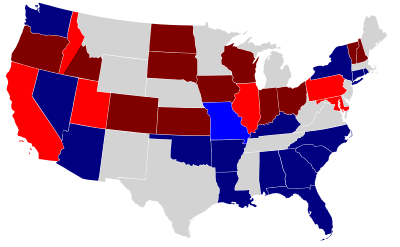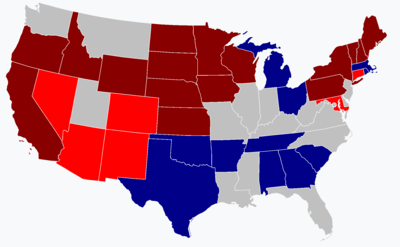1950 United States elections
The 1950 United States elections were held on November 7, 1950, and elected the members of the 82nd United States Congress. The election took place during the Korean War, during Democratic President Harry S. Truman's second (only full) term. The Democrats lost twenty-eight seats to the Republican Party in the House of Representatives. The Democrats also lost five seats in the U.S. Senate to the Republicans.[2] Congressman Vito Marcantonio's defeat left third parties without representation in Congress for the first time since 1908.
| Midterm elections | |
| Election day | November 7 |
|---|---|
| Incumbent president | Harry S. Truman (Democratic) |
| Next Congress | 82nd |
| Senate elections | |
| Overall control | Democratic Hold |
| Seats contested | 36 of 96 seats (32 Class 3 seats + 6 special elections)[1] |
| Net seat change | Republican +5 |
 | |
| 1950 Senate election results
Democratic gain Democratic hold | |
| House elections | |
| Overall control | Democratic Hold |
| Seats contested | All 435 voting seats |
| Popular vote margin | Democratic +0.7% |
| Net seat change | Republican +28 |
| Gubernatorial elections | |
| Seats contested | 33 |
| Net seat change | Republican +6 |
 | |
| 1950 gubernatorial election results
Democratic gain Democratic hold | |
Like his predecessor Franklin D. Roosevelt in 1938, Truman and the Democratic party managed to maintain control of both houses, defying the six-year itch phenomenon for the second time in a row. However, the election was still a defeat for Truman, as it strengthened the conservative coalition and ensured that none of Truman's Fair Deal policies would pass. Republicans also ran against Truman's prosecution of the Korean War, and the 82nd Congress subsequently conducted numerous investigations into the course of the war. The election set the stage for the presidency of Republican Dwight D. Eisenhower and the centrist policies of the 1950s.[3]
See also
References
- Two Class 3 seats held both a regularly-scheduled election and a special election in 1950. These two seats are not double-counted for the total number of seats contested.
- "Statistics of the Congressional Election of November 7, 1950" (PDF). U.S. House of Reps, Office of the Clerk.
- Busch, Andrew (1999). Horses in Midstream. University of Pittsburgh Press. pp. 91–94.